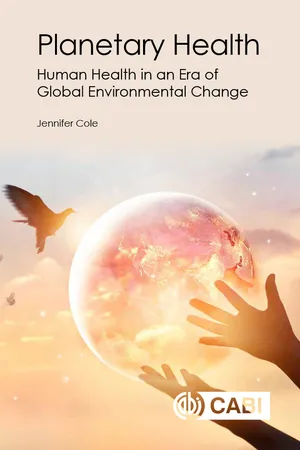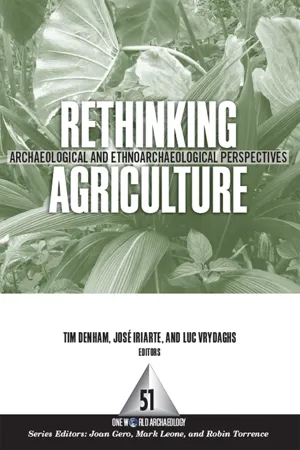Biological Sciences
Agriculture
Agriculture is the practice of cultivating soil, producing crops, and raising livestock for human use. It involves various biological processes such as plant growth, soil fertility, and animal husbandry. Agriculture plays a crucial role in providing food, fiber, and other resources essential for human survival and economic development.
Written by Perlego with AI-assistance
Related key terms
3 Key excerpts on "Agriculture"
- eBook - ePub
Planetary Health
Human Health in an Era of Global Environmental Change
- Jennifer Cole(Author)
- 2019(Publication Date)
- CAB International(Publisher)
11 Agriculture: Land Use, Food Systems and BiodiversityJennifer Cole Royal Holloway, University of London and University of Oxford, UK11.1 Farming and Human Progress
Agriculture is defined as the science and practice of farming. It includes cultivating the soil to grow crops, and rearing animals to provide food (including meat, eggs and dairy), products (such as wool, fur and leather) and to use as work animals. Its emergence has enabled humanity to prosper (Jacobs, 1961 ). Large-scale farming, helped by irrigation, frees people from hunter-gatherer and subsistence existences by providing a more secure and centralized food supply, which also allows them to settle, organize into larger towns and cities and to develop more complex, stratified societies. Surplus food can be stored for the winter, to protect against times of scarcity and can be traded for other goods and services. It is no longer necessary for everyone to be involved in food provision or production, facilitating the stratification of urban society that enables scholars, engineers, scientists and doctors to emerge (Toye, 2004 ).Agriculture has been extremely positive for humankind but the environment has not necessarily fared so well. Dramatic changes in land use, water systems and, in more modern times, the large-scale use of artificial fertilizers and pesticides do not always have a positive impact on the natural world and its ecosystems: Agriculture contributes to greenhouse gas emissions, water stress, soil degradation and biodiversity loss.In addition, Agriculture has separated humans from nature. Members of society who are not involved in food production may no longer interact with the natural world, which has implications on physical health, including diet, the immune system, activity levels and mental health (Rook et al., 2017 ; Wells et al., 2017 - eBook - ePub
Rethinking Agriculture
Archaeological and Ethnoarchaeological Perspectives
- Timothy P Denham, José Iriarte, Luc Vrydaghs(Authors)
- 2016(Publication Date)
- Routledge(Publisher)
Oxford English Dictionary (1971) defines Agriculture as ‘The science and art of cultivating the soil, including the allied pursuits of gathering in the crops and rearing live stock [sic]; tillage, husbandry, farming (in the widest sense)’.Most students of agricultural history regard livestock raising as part of ‘Agriculture’. However, we should remember that this view stems from Eurasian traditions of ‘agro-pastoralism’ whereby in Southwest Asia goats, sheep and later cattle became fully integrated with the cultivation of cereal and pulse crops (Harris 1998, 2002), and in central China water buffalos became an integral part of the system of wet-rice (padi) cultivation (Glover and Higham 1996: 428; Underhill 1997: 141–44). Such integration, in which the animals provide food, fertilizer and traction, did not occur in other regions of early Agriculture where domestic livestock were present but not fully incorporated into the indigenous systems of seed and root crop cultivation, for example the central Andes and northern tropical Africa. In yet other regions domestic animals were only linked to crop production as consumers, for example turkeys in Mexico and pigs in highland New Guinea. Although prehistoric and early historic agricultural systems varied widely in the extent to which domestic animals were incorporated into the production process, it is appropriate to regard livestock raising as part of ‘Agriculture’, provided that we are careful to distinguish and define particular systems of agricultural production within the overarching concept. There are many types of such systems, for example shifting (swidden) cultivation and irrigation Agriculture in its various manifestations, which need not be detailed here, but pastoral systems call for comment because the terms used to describe forms of pastoralism are often vague and confusing. - eBook - ePub
Computerized Literature Searching
Research Strategies And Databases
- Charles L. Gilreath(Author)
- 2019(Publication Date)
- Routledge(Publisher)
3 Agricultural and Life SciencesCharacteristics and Terminology
Literature resources for the study of agricultural and life sciences are among the richest and most diverse of any field. They encompass all major types of publications from patents and technical reports to monographic treatises and journal articles. The subject matter of interest to life scientists is equally diverse, covering topics ranging from improved electrophoretic techniques to population studies of waterfowl, from the taxonomy of Lepidoptera species to the epidemiology of Legionnaire's Disease.In this field, specialties and subspecialties abound to such an extent that any attempts at disciplinary classification inevitably fail. For purposes of discussion here the fields usually subsumed by the following academic departments will be included: Animal Science, Plant Science, Entomology, Biology, Biochemistry, Biophysics, Human and Veterinary Medicine, Forest Science, Food Science, Soil Science, and Agronomy. Bibliographic tools for control of the literature in these fields abound at several levels of specificity. Large, general purpose abstracting and indexing services such as Biological Abstracts and Science Citation Index cover the major publications of the life sciences very broadly, while other services such as Herbage Abstracts, Microbiology Abstracts, and Reviews of Applied Entomology cover in more detail the publications of specific subdisciplines.With a few notable exceptions, most of the major indexes and abstracting services can be searched via computer for references published during the past several years. Given the history of computer search systems, the time span covered by individual online versions of these bibliographic services will vary, but the typical system will cover the literature of the past five to ten years, with a few services extending coverage back as far as the mid-1960s. Time coverage will frequently be a factor in a scientist's decision whether or not to undertake a computer search. If the topic under investigation is one in which a substantial volume of the relevant literature has been written in the last decade, then a computer search can be an effective aid to the library research. New research areas such as genetic engineering and space medicine will be particularly well served by computer-searchable systems. Other fields—many of the plant and animal science specialties, for example—in which the research output has been relatively steady over a long period of time will also be well served by computer searching. In this latter case the researcher may choose to search current literature online, realizing that although the results will not be a complete search of the published record, good citations retrieved by the search will likely have bibliographic references to key papers published in the past. In this manner a thorough search of the most recent ten years of literature may yield results that, in effect, give coverage of fifteen to twenty years of significant research.
Learn about this page
Index pages curate the most relevant extracts from our library of academic textbooks. They’ve been created using an in-house natural language model (NLM), each adding context and meaning to key research topics.


